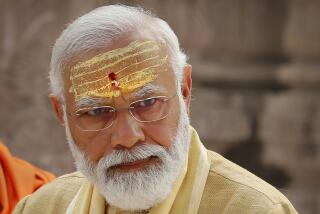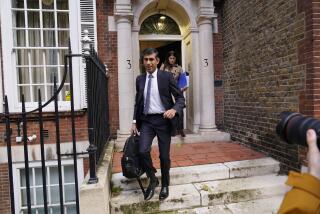New India Leader Focuses on Poor
- Share via
NEW DELHI — Incoming Prime Minister Manmohan Singh promised Thursday that he would reshape economic reforms to benefit millions of India’s poor, protect workers in state-run firms and boost farm output.
“I have always been saying that we need reforms,” Singh told reporters here. “We will increase reforms, but it will be reforms with a human face, reforms that benefit the common man of our country.”
For the record:
12:00 a.m. May 22, 2004 For The Record
Los Angeles Times Saturday May 22, 2004 Home Edition Main News Part A Page 2 National Desk 0 inches; 28 words Type of Material: Correction
Indian official -- An article Friday in Section A about India’s incoming government referred to Jaswant Singh as a former prime minister. He is a former finance minister.
Singh said his coalition government’s goal was to be friendly to investors while addressing some of India’s most chronic problems, such as poorly funded hospitals and schools and the lack of proper housing for hundreds of millions living in poverty.
“It’s a very difficult task,” said Singh, an Oxford-educated economist. “But we in India have, since time immemorial, proved that we don’t get unnerved by difficulties.”
Although India’s economy has grown at an annual rate of about 8% in recent months, the central bank predicts growth will slow over the next year. That won’t make it easier for Singh to tackle several economic problems, such as large -- and growing -- budget and trade deficits.
He may be sworn in as prime minister as early as Saturday if he can finish hard bargaining with coalition allies over Cabinet posts.
The Congress Party’s Italian-born president, Sonia Gandhi, refused to take the prime minister’s job under withering attacks from Hindu nationalists over her foreign roots. But she is expected to have a hand in Singh’s government whether or not she is a member of his Cabinet.
Singh also vowed to make progress in peace talks with Pakistan, which are due to begin soon. The central issue, and the most difficult to resolve, is the decades-old dispute over the divided Kashmir region.
“We must find ways and means to resolve all outstanding problems that have been a source of friction, without sacrificing our national security imperatives, to create an environment to move forward and improve our relations with Pakistan on a priority basis,” he said.
Singh repeated that his government would not sell profitable state-owned firms, or those he called “enterprises of strategic nature,” such as oil companies and banks. India’s state-run banks handle almost 70% of loans and other banking transactions. Free-market advocates say that puts a heavy drag on the economy.
As finance minister from 1991 to 1996, Singh began opening India’s economy to foreign capital and trade and loosening government controls. He told his many opponents there was no choice -- the country was headed for bankruptcy.
India had an economic growth rate below 1% a year and $1 billion in foreign currency reserves then. Now, to go with the stronger growth, the central bank has more than $110 billion in hard currency.
But Singh still has enormous economic problems on his hands. In addition to the federal budget and trade deficits, he faces huge state budget deficits, complex tariff barriers and regulations, prolonged drought in several states, rampant corruption, crumbling infrastructure and chronic shortages of power and clean water.
Anne Krueger, acting managing director of the International Monetary Fund, warned last month that India’s economic and development growth were at risk as long as its government continued to run up what she called an unsustainable deficit. Most analysts consider the budget deficit the country’s most important issue, Krueger told reporters in Washington.
“They are addressing it, but it is still very large,” she said. “In my judgment, the Indian economy, the Indian people, the Indian poor would be better off if that problem were more rapidly addressed.”
This year, India’s federal government plans to spend about $34 billion more than it earns through taxes and other revenues, equal to about 6% of gross domestic product. If state governments are included, the rate rises to 10%.
The average for developing countries is 4% of GDP, Harvard economist Martin Feldstein said at a January conference at India’s central bank. The U.S. budget deficit, which has ballooned since the Sept. 11 attacks, is projected to be 4.3% next year, he added.
India’s huge deficits will knock at least 10% off the economy’s potential growth over the next decade, Feldstein said.
“Like obesity, government deficits are the result of too much self-indulgent living as the government spends more than it collects in taxes,” he said. “And, also like obesity, the more severe the problem, the harder it is to correct.”
Millions of tax dodgers will make it hard for Singh to reduce the deficit. Many Indians evade paying income tax, and large corporations often top the annual list of the biggest defaulters.
Indians “are the world’s specialists in not paying taxes,” former Prime Minister Jaswant Singh said last month.
More to Read
Sign up for Essential California
The most important California stories and recommendations in your inbox every morning.
You may occasionally receive promotional content from the Los Angeles Times.













